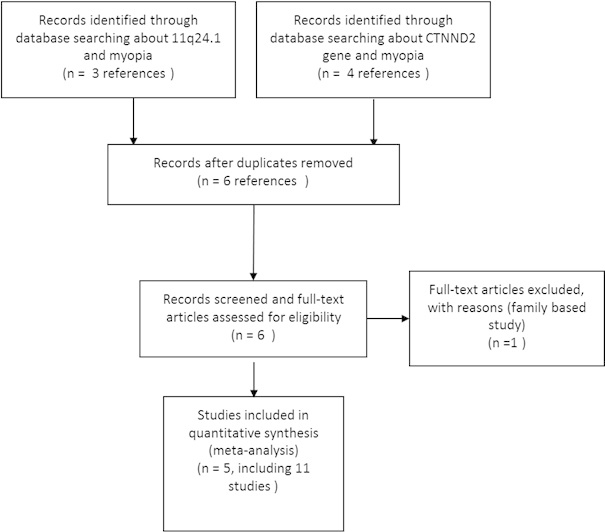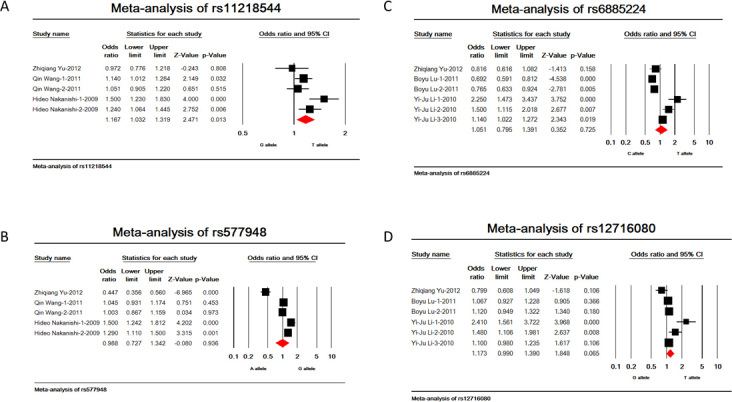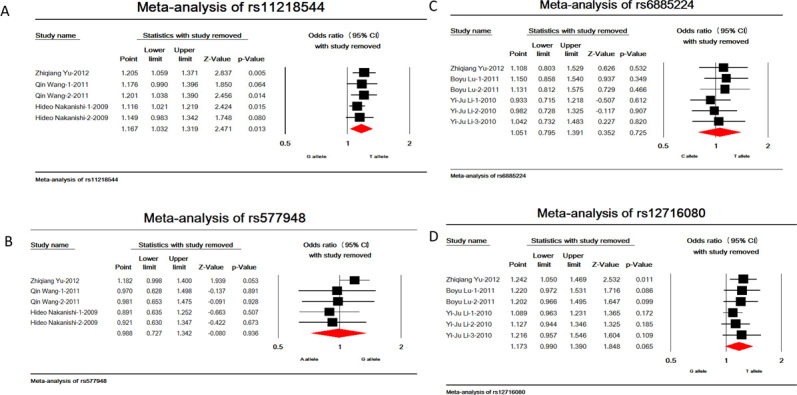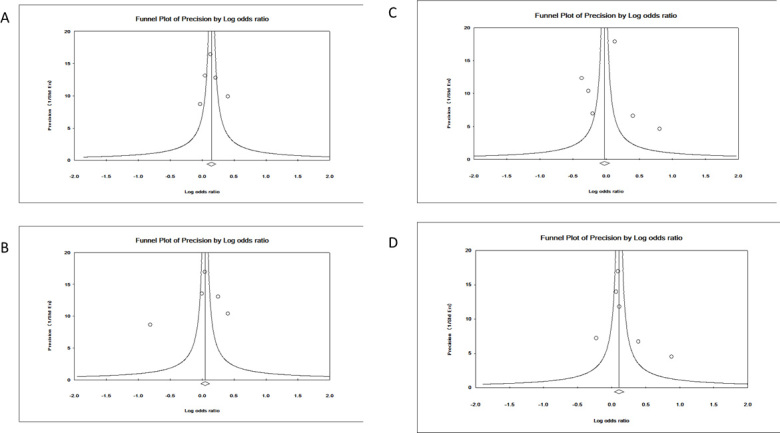Abstract
Purpose
To evaluate the association of polymorphisms in the 11q24.1 genomic region and the CTNND2 gene with myopia.
Methods
We conducted a comprehensive meta-analysis included 6,954 cases and 9,346 controls. Odds ratios (ORs) were calculated using Carlin’s method. Publication bias was assessed using Egger et al.’s approach. Sensitivity, heterogeneity, and trim and fill analyses were also conducted.
Results
For the 11q24.1 genomic region, the rs11218544 polymorphism showed significant association with myopia [OR and 95% confidence interval (CI): 1.167 (1.032–1.319), p=0.013], while rs577948 showed no association with the disease [OR and 95%CI: 0.988 (0.727–1.342), p=0.936]. For the CTNND2 gene, neither rs6885224 nor rs12716080 was significantly associated with myopia {rs6885224: [OR and 95%CI: 1.051 (0.795–1.391), p=0.725], rs12716080: [OR and 95%CI: 1.173 (0.990–1.390), p=0.065]}.
Conclusions
Our study indicated that the 11q24.1 genomic region, and particularly the rs11218544 polymorphism, has a genetic association with the development of myopia.
Introduction
Myopia (nearsightedness) is one of the most common visual disorders affecting both children and adults, with an average prevalence of 30% worldwide [1-3]. It is a refractive error of the eye in which parallel rays of light focus anterior of the retinal plane, resulting in blurred vision. The myopia rates among East Asians, especially in the Chinese and Japanese populations, are much higher than in Europeans [4,5].
The etiology of myopia is known to be knotted [6]. The environmental influences in the development of the disease have been indicated from many epidemiological studies [7,8]. However, a large body of research, especially that involving twin and familial studies, has shown that genetic factors play important roles in the pathogenesis of myopia [9,10]. Molecular genetic study provides a special tool to study the molecular basis of myopia. Genome-wide association studies (GWAS) have identified single-nucleotide polymorphisms (SNPs) in different chromosomal regions that are significantly associated with myopia [11-13]. Linkage studies have mapped many myopia susceptibility loci. However, the exact genes in these loci that are responsible for the progression of myopia remain to be identified in further studies.
Chinese and Japanese populations exhibit a very high prevalence of myopia. In addition, the populations from these two countries are closely related [14]. Additionally, the LD structures of rs577948, rs11218544, rs12716080, and rs6885224 are very similar between the two populations. Given these considerations, we conducted the present comprehensive meta-analysis to evaluate whether these four polymorphisms of the CTNND2 gene and the 11q24.1 genomic region are associated with myopia in Chinese and Japanese populations.
Methods
Search strategy
To assess the total evidence of association between the CTNND2 gene and myopia disease, and between 11q24.1 genomic region and myopia, we performed the present comprehensive meta-analysis of published studies. A total of 11 studies focusing either on the association between the CTNND2 gene and myopia or between the 11q24.1 genomic region and myopia were identified according to our inclusion criteria; these publications comprised 6,954 cases and 9,346 controls [11,15-18]. The main characteristics of these studies are given in Table 1. We considered all studies that examined the association of the rs577948, rs11218544, rs12716080, and rs6885224 polymorphisms with myopia. Sources included MEDLINE and EMBASE (search last updated in Aug. 2012). The search strategy was based on combinations of the terms “CTNND2,” “T-cell delta-catenin,” “catenin delta-2,” “11q24.1 genomic region,” and “myopia.” Reference lists in the retrieved articles were also screened.
Table 1. Characteristics of the studies included.
| Study ( reference number) | Year | Ethnicity | Region | Polymorphisms | Numbers |
Mean age |
||
|---|---|---|---|---|---|---|---|---|
| Case (Female+Male) | Control (Female+Male) | Case (mean±SD) | Control (mean±SD) | |||||
| Zhiqiang Yu [15] |
2012 |
Chinese |
CTNND2 gene |
rs12716080, rs6885224 |
321 (163+158) |
310 (142+168) |
27.5±17.1 |
41.3±12.4 |
| Boyu Lu-1 [16] |
2011 |
Chinese |
CTNND2 gene |
rs12716080, rs6885224 |
1203 (610+593) |
955 (397+558) |
18.53±6.64 |
24.49±2.82 |
| Boyu Lu-2 [16] |
2011 |
Chinese |
CTNND2 gene |
rs12716080, rs6885224 |
615 (306+309) |
955 (397+558) |
20.70±1.59 |
24.49±2.82 |
| Yi-Ju Li-1 [17] |
2010 |
Chinese |
CTNND2 gene |
rs12716080, rs6885224 |
65 (/) |
238 (/) |
(/) |
(/) |
| Yi-Ju Li-2 [17] |
2010 |
Chinese |
CTNND2 gene |
rs12716080, rs6885224 |
222 (/) |
435 (/) |
(/) |
(/) |
| Yi-Ju Li-3 [17] |
2010 |
Japanese |
CTNND2 gene |
rs12716080, rs6885224 |
929 (481+448) |
2008 (921+1087) |
10.83±0.83 |
47.9±11.18 |
| Zhiqiang Yu [15] |
2012 |
Chinese |
11q24.1 genomic region |
rs577948,
rs12118544 |
321 (163+158) |
310 (142+168) |
27.5±17.1 |
41.3±12.4 |
| Qin Wang-1 [18] |
2011 |
Chinese |
11q24.1 genomic region |
rs577948,
rs12118544 |
1255 (641+614) |
1052 (443+609) |
20.70±1.59 |
20.91±1.78 |
| Qin Wang-2 [18] |
2011 |
Chinese |
11q24.1 genomic region |
rs577948,
rs12118544 |
563 (274+289) |
1052 (443+609) |
20.06±14.01 |
20.91±1.78 |
| Hideo Nakanishi-1 [11] |
2009 |
Japanese |
11q24.1 genomic region |
rs577948,
rs12118544 |
297 (204+93) |
934 (/) |
58.8±13.2 |
/ |
| Hideo Nakanishi-2 [11] | 2009 | Japanese | 11q24.1 genomic region | rs577948, rs12118544 | 533 (362+171) | 977 (480+497) | 59.0±14.3 | 48.3±16.3 |
"(/)" means the information is not available in the reference.
Inclusion and exclusion criteria
All the studies included satisfied all the following criteria: (1) They were association studies either between the rs12716080 and rs6885224 polymorphisms in the CTNND2 gene and myopia disease or between the rs577948 and rs11218544 polymorphisms and myopia; (2) they used myopia-free people as controls; (3) they provided genotype or allele distributions in both the case and control groups; and (4) they were independent studies and the subject groups investigated did not overlap with each other. Authors were contacted where clarification was required.
Only studies published in English were included. Studies presenting nonoriginal data were excluded, such as reviews, editorials, opinion papers, or letters to the editor. Studies using nonhuman subjects or specimens were excluded. Studies with no extractable numerical data were excluded. Only those articles that had some measure of diagnostic performance were included. Any duplicates that came up in the preliminary search were excluded.
Data extraction
The following information was independently extracted from the identified studies by two participants in the meta-analysis: first author, journal, year of publication, study design, ethnicity of the study population, gender, clinical characteristics, genotyping method, the number of cases and controls or odds ratio (OR) and 95 percent confidence interval (95%CI), country in which the study was conducted, and confirmation of diagnosis. The results were compared and any disagreement was discussed and resolved by consensus.
Statistical analysis
We used a comprehensive meta-analysis to analyze the ORs using Carlin’s method [19]. To determine whether the results of the meta-analysis were unduly influenced by any one study, we recomputed the meta-analysis statistics after deleting each study one at a time. We assessed publication bias using Egger et al.’s approach [20]. This method is based on the fact that the precision of the OR increases with larger study groups. It regresses the standard normal deviation of the OR (the OR divided by its standard error) against the precision of the OR (the inverse of its standard error). In the absence of bias, Egger et al. [20] showed that the regression of the standard normal deviate on the precision of the OR should run through the origin (i.e., small study groups with low precision have large standard errors and therefore small standard normal deviates; large study groups have higher precision, smaller standard errors, and large standard normal deviates). The publication bias statistic of Egger et al. [20] is the intercept of the regression, which will be significantly greater than zero in the presence of publication bias.
The random effects model using the DerSimonian and Laird method was employed, and the estimate of heterogeneity was determined using the Mantel–Haenszel model [21]. Heterogeneity among studies was tested using the Q and I2 statistics. The effect size was represented by an OR with 95%CI. Sensitivity analysis was conducted by removing each study and analyzing the others to ensure that no single study was totally responsible for overall results. Every time, each study was removed in turn from the total, and the remainder was reanalyzed. This procedure was used to ensure that no individual study was entirely responsible for a finding. Between-study heterogeneity was tested using Cochran’s Q statistic, which is considered significant at p<0.10. The extent of inconsistency across studies was quantified with the I2 statistic. The I2 ranges between 0 and 100%. When there was very large or large (>50%) between-study heterogeneity, we used a simulation algorithm to evaluate how many studies had to be removed for the I2 to reach <25%.
The significance level was set at 0.05, and all p values were two-tailed. The comprehensive meta-analysis was performed using Comprehensive Meta Analysis software (Version 2.2.046, BIOSTAT, Englewood, NJ) [22-24].
Results
Eligible studies
The combined search yielded seven references. These were then filtered to ensure conformity with the inclusion criteria. One reference was discarded because it was a family-based study. Ultimately, six references met our criteria (Table 1, Figure 1).
Figure 1.

Process used to select published studies for a systematic review and genetic study between 2009 and Aug. 2012. MeSH: Medical Subject Headings.
Synthesis of quantitative data
The eligible studies for analysis included a total of 6,954 cases with myopia and 9,346 controls (Table 1). For the 11q24.1 genomic region, the rs11218544 polymorphism showed significantly association with myopia [OR and 95% CI: 1.167 (1.032–1.319), p=0.013], and rs577948 showed no association with the disease [OR and 95% CI: 0.988 (0.727–1.342), p=0.936]. For the CTNND2 gene, neither the rs6885224 nor rs12716080 polymorphism was significantly associated with myopia {rs6885224: [OR and 95% CI: 1.051 (0.795–1.391), p=0.725], rs12716080: [OR and 95% CI: 1.173 (0.990–1.390), p=0.065; Figure 2A-D).
Figure 2.

Meta-analysis of association studies of the polymorphisms and myopia. A: rs11218544, B: rs677948, C: rs6885224, D: rs12716080. Pooled overall OR is shown. The OR of each study is marked with a black square. Pooled OR is indicated by a red diamond.
Publication bias and heterogeneity
The sensitivity analysis showed that when any one of the studies was removed, the heterogeneity of the population was not changed deeply; namely, when one study was removed, the result was still significant (Figure 3A-D). This indicated that no heterogeneity existed in the population. There was no evidence to suggest that the magnitude of the overall OR estimates changed in the same direction over time. Moreover, the Egger funnel plots of publication bias analysis for four polymorphisms were shown (Figure 4A-D).
Figure 3.

The sensitivity analysis of the polymorphisms. A: rs11218544, B: rs677948, C: rs6885224, D: rs12716080. When any one of the studies was removed, the heterogeneity of the population remained unchanged.
Figure 4.

Egger’s funnel plots of publication bias analysis for the polymorphisms. A: rs11218544, B: rs677948, C: rs6885224, D: rs12716080. The larger the deviation from the funnel curve of each study, the more pronounced the asymmetry. Results from small studies scatter widely at the bottom of the graph, with the spread narrowing among larger studies.
Discussion
This comprehensive meta-analysis was designed to further evaluate the importance of 11q24.1 loci and the CTNND2 gene as potential susceptibility loci for myopia. Our results indicated that the 11q24.1 genomic region, and particularly the rs11218544 polymorphism, was significantly associated with myopia. On the other hand, the results for the CTNND2 gene were not in the same direction as those reported by Lu et al. and Li et al. [16,17]. In Boyu Lu’s study, the researchers found that rs6885224 was significantly associated with myopia, whereas rs12716080 was not. In Li et al.’s [17] study, it was reported that both the rs6885224 and rs12716080 polymorphisms were significantly associated with myopia.
In this study, we accessed as much of the literature as possible to achieve a complete and unbiased representation of the relevant research. Those studies with insufficient or ambiguous data were excluded. This effort to take a comprehensive and even-handed approach to the literature inclusion may have strengthened the robustness of the findings while avoiding publication bias and minimizing heterogeneity [25]. Compared with previous studies, this current meta-analysis pooled larger sample sizes, generated even more significant results with systematic design types and analysis approaches, and included tests of heterogeneity and sensitivity analyses. The current results demonstrate the robustness of the associations between the 11q24.1 genomic region and the disease, which was significant in some studies and not in others. As a polygenic disease, myopia is caused by the combined actions of many factors. For greater insight into its genetic component, more work is required to confirm the role of other genes that may have a small effect, and to identify new genetic risk factors. The large samples required will necessitate multisite projects and meta-analyses based on national and international collaboration.
In summary, this comprehensive meta-analysis supports the significant association of markers in the 11q24.1 genomic region with myopia, and no significant association of markers in the CTNND2 gene with the disease. It remains unclear why the associated alleles vary across studies. Identification of functional variants will probably require biological and additional genetic assays.
Acknowledgments
J. Liu designed the study. J. Liu and HX. Zhang performed the statistical analysis and drafted the manuscript. All authors critically revised the manuscript and gave final approval of the article for submission. This work is supported by grants from the National Natural Science Foundation of China (31000408) and the Science and Technology Commission of Shanghai municipality (13ZR1461100). The funders had no role in study design, data collection and analysis, decision to publish, or preparation of the manuscript.
References
- 1.Kempen JH, Mitchell P, Lee KE, Tielsch JM, Broman AT, Taylor HR, Ikram MK, Congdon NG, O'Colmain BJ, Eye Diseases Prevalence Research Group The prevalence of refractive errors among adults in the United States, Western Europe, and Australia. Arch Ophthalmol. 2004;122:495–505. doi: 10.1001/archopht.122.4.495. [DOI] [PubMed] [Google Scholar]
- 2.Vitale S, Ellwein L, Cotch MF, Ferris FL, 3rd, Sperduto R. Prevalence of refractive error in the United States, 1999–2004. Arch Ophthalmol. 2008;126:1111–9. doi: 10.1001/archopht.126.8.1111. [DOI] [PMC free article] [PubMed] [Google Scholar]
- 3.Young TL. Molecular genetics of human myopia: an update. Optom Vis Sci. 2009;86:E8–22. doi: 10.1097/OPX.0b013e3181940655. [DOI] [PMC free article] [PubMed] [Google Scholar]
- 4.Hosaka A. Population studies-myopia experience in Japan. Acta Ophthalmol Suppl. 1988;185:37–40. doi: 10.1111/j.1755-3768.1988.tb02659.x. [DOI] [PubMed] [Google Scholar]
- 5.He M, Zheng Y, Xiang F. Prevalence of myopia in urban and rural children in mainland China. Optom Vis Sci. 2009;86:40–4. doi: 10.1097/OPX.0b013e3181940719. [DOI] [PubMed] [Google Scholar]
- 6.Morgan I, Rose K. How genetic is school myopia? Prog Retin Eye Res. 2005;24:1–38. doi: 10.1016/j.preteyeres.2004.06.004. [DOI] [PubMed] [Google Scholar]
- 7.Saw SM, Chua WH, Hong CY, Wu HM, Chan WY, Chia KS, Stone RA, Tan D. Nearwork in early-onset myopia. Invest Ophthalmol Vis Sci. 2002;43:332–9. [PubMed] [Google Scholar]
- 8.Wong TY, Foster PJ, Johnson GJ, Seah SK. Education, socioeconomic status, and ocular dimensions in Chinese adults: the Tanjong Pagar Survey. Br J Ophthalmol. 2002;86:963–8. doi: 10.1136/bjo.86.9.963. [DOI] [PMC free article] [PubMed] [Google Scholar]
- 9.Hammond CJ, Snieder H, Gilbert CE, Spector TD. Genes and environment in refractive error: the twin eye study. Invest Ophthalmol Vis Sci. 2001;42:1232–6. [PubMed] [Google Scholar]
- 10.Lyhne N, Sjølie AK, Kyvik KO, Green A. The importance of genes and environment for ocular refraction and its determiners: a population based study among 20–45 year old twins. Br J Ophthalmol. 2001;85:1470–6. doi: 10.1136/bjo.85.12.1470. [DOI] [PMC free article] [PubMed] [Google Scholar]
- 11.Nakanishi H, Yamada R, Gotoh N, Hayashi H, Yamashiro K, Shimada N, Ohno-Matsui K, Mochizuki M, Saito M, Iida T, Matsuo K, Tajima K, Yoshimura N, Matsuda F. A genome-wide association analysis identified a novel susceptible locus for pathological myopia at 11q24.1. PLoS Genet. 2009;5:e1000660. doi: 10.1371/journal.pgen.1000660. [DOI] [PMC free article] [PubMed] [Google Scholar]
- 12.Hysi PG, Young TL, Mackey DA, Andrew T, Fernández-Medarde A, Solouki AM, Hewitt AW, Macgregor S, Vingerling JR, Li YJ, Ikram MK, Fai LY, Sham PC, Manyes L, Porteros A, Lopes MC, Carbonaro F, Fahy SJ, Martin NG, van Duijn CM, Spector TD, Rahi JS, Santos E, Klaver CC, Hammond CJ. A genome-wide association study for myopia and refractive error identifies a susceptibility locus at 15q25. Nat Genet. 2010;42:902–5. doi: 10.1038/ng.664. [DOI] [PMC free article] [PubMed] [Google Scholar]
- 13.Solouki AM, Verhoeven VJ, van Duijn CM, Verkerk AJ, Ikram MK, Hysi PG, Despriet DD, van Koolwijk LM, Ho L, Ramdas WD, Czudowska M, Kuijpers RW, Amin N, Struchalin M, Aulchenko YS, van Rij G, Riemslag FC, Young TL, Mackey DA, Spector TD, Gorgels TG, Willemse-Assink JJ, Isaacs A, Kramer R, Swagemakers SM, Bergen AA, van Oosterhout AA, Oostra BA, Rivadeneira F, Uitterlinden AG, Hofman A, de Jong PT, Hammond CJ, Vingerling JR, Klaver CC. A genome-wide association study identifies a susceptibility locus for refractive errors and myopia at 15q14. Nat Genet. 2010;42:897–901. doi: 10.1038/ng.663. [DOI] [PMC free article] [PubMed] [Google Scholar]
- 14.HUGO Pan-Asian SNP Consortium Abdulla MA, Ahmed I, Assawamakin A, Bhak J, Brahmachari SK, Calacal GC, Chaurasia A, Chen CH, Chen J, Chen YT, Chu J, Cutiongco-de la Paz EM, De Ungria MC, Delfin FC, Edo J, Fuchareon S, Ghang H, Gojobori T, Han J, Ho SF, Hoh BP, Huang W, Inoko H, Jha P, Jinam TA, Jin L, Jung J, Kangwanpong D, Kampuansai J, Kennedy GC, Khurana P, Kim HL, Kim K, Kim S, Kim WY, Kimm K, Kimura R, Koike T, Kulawonganunchai S, Kumar V, Lai PS, Lee JY, Lee S, Liu ET, Majumder PP, Mandapati KK, Marzuki S, Mitchell W, Mukerji M, Naritomi K, Ngamphiw C, Niikawa N, Nishida N, Oh B, Oh S, Ohashi J, Oka A, Ong R, Padilla CD, Palittapongarnpim P, Perdigon HB, Phipps ME, Png E, Sakaki Y, Salvador JM, Sandraling Y, Scaria V, Seielstad M, Sidek MR, Sinha A, Srikummool M, Sudoyo H, Sugano S, Suryadi H, Suzuki Y, Tabbada KA, Tan A, Tokunaga K, Tongsima S, Villamor LP, Wang E, Wang Y, Wang H, Wu JY, Xiao H, Xu S, Yang JO, Shugart YY, Yoo HS, Yuan W, Zhao G, Zilfalil BA; Indian Genome Variation Consortium. Mapping human genetic diversity in Asia. Science. 2009;326:1541–5. [Google Scholar]
- 15.Yu Z, Zhou J, Chen X, Zhou X, Sun X, Chu R. Polymorphisms in the CTNND2 Gene and 11q24.1 Genomic Region Are Associated with Pathological Myopia in a Chinese Population. Ophthalmologica. 2012;228:123–9. doi: 10.1159/000338188. [DOI] [PubMed] [Google Scholar]
- 16.Lu B, Jiang D, Wang P, Gao Y, Sun W, Xiao X, Li S, Jia X, Guo X, Zhang Q. Replication study supports CTNND2 as a susceptibility gene for high myopia. Invest Ophthalmol Vis Sci. 2011;52:8258–61. doi: 10.1167/iovs.11-7914. [DOI] [PubMed] [Google Scholar]
- 17.Li YJ, Goh L, Khor CC, Fan Q, Yu M, Han S, Sim X, Ong RT, Wong TY, Vithana EN, Yap E, Nakanishi H, Matsuda F, Ohno-Matsui K, Yoshimura N, Seielstad M, Tai ES, Young TL, Saw SM. Genome-wide association studies reveal genetic variants in CTNND2 for high myopia in Singapore Chinese. Ophthalmology. 2011;118:368–75. doi: 10.1016/j.ophtha.2010.06.016. [DOI] [PMC free article] [PubMed] [Google Scholar]
- 18.Wang Q, Gao Y, Wang P, Li S, Jia X, Xiao X, Guo X, Zhang Q. Replication study of significant single nucleotide polymorphisms associated with myopia from two genome-wide association studies. Mol Vis. 2011;17:3290–9. [PMC free article] [PubMed] [Google Scholar]
- 19.Carlin JB. Meta-analysis for 2 × 2 tables: a Bayesian approach. Stat Med. 1992;11:141–58. doi: 10.1002/sim.4780110202. [DOI] [PubMed] [Google Scholar]
- 20.Egger M, Davey Smith G, Schneider M, Minder C. Bias in metaanalysis detected by a simple, graphical test. BMJ. 1997;315:629–34. doi: 10.1136/bmj.315.7109.629. [DOI] [PMC free article] [PubMed] [Google Scholar]
- 21.Cohn LD, Becker BJ. How meta-analysis increases statistical power. Psychol Methods. 2003;8:243–53. doi: 10.1037/1082-989X.8.3.243. [DOI] [PubMed] [Google Scholar]
- 22.Liu J, Zhang HX. Significant study of population stratification, sensitivity analysis and trim and fill analyses on GBA mutation and parkinson's disease. Am J Med Genet B Neuropsychiatr Genet. 2014;165:96–102. doi: 10.1002/ajmg.b.32214. [DOI] [PubMed] [Google Scholar]
- 23.Liu J, Zhang HX. A comprehensive study indicates PRSS1 gene is significantly associated with pancreatitis. Int J Med Sci. 2013;10:981–7. doi: 10.7150/ijms.6164. [DOI] [PMC free article] [PubMed] [Google Scholar]
- 24.Liu J, Zhang H. −1722T/C polymorphism (rs733618) of CTLA-4 significantly associated with systemic lupus erythematosus (SLE): a comprehensive meta-analysis. Hum Immunol. 2013;74:341–7. doi: 10.1016/j.humimm.2012.12.009. [DOI] [PubMed] [Google Scholar]
- 25.Munafö MR, Flint J. Meta-analysis of genetic association studies. Trends Genet. 2004;20:439–44. doi: 10.1016/j.tig.2004.06.014. [DOI] [PubMed] [Google Scholar]


